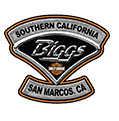Safe Riding in the Rain

With fall comes cooler weather and more precipitation. For motorcycle riders, that can be a dangerous combination. Rain brings many potential factors into play, and if you aren’t prepared to deal with them, you could find yourself in trouble.
We created this short guide to teach our customers some of the basics for riding in the rain. Obviously this shouldn’t take the place of a professional riding course, but hopefully it will serve as a good refresher. If you need parts or service for your motorcycle, stop by Biggs Harley-Davidson®. We’re located near Carlsbad, California, and we proudly serve the areas of Encinitas, Oceanside, and San Diego as well as Roway, Rancho Santa Fe and San Luis Rey, California.
Choosing Good Equipment
Having good riding gear is the first step towards being safe in the rain. A full body riding suit is the best way to stay warm and dry. While it’s easy for cold air to permeate the gap between where your pants and jacket meet, with a full body riding suit, you’ll be totally protected. It’s also a good idea to invest in some waterproof gloves and insulated boots. The hands and feet are often the first things to get cold because they have a lot of surface area, but minimal protective tissue to retain heat. When hands and feet get cold, they lose dexterity, and that can make controlling your bike more difficult.
Keeping water away from your face and eyes is crucial. A full face helmet with a face shield is the best option for head protection. You might want to also invest in some form of neck protection, such as a gator or scarf, because otherwise air will go down your collar.
Low Traction Areas
Traction is the key question when riding in the rain. Water on the road will reduce the amount of friction between your tires and the pavement, and friction is what gives you the traction you need to accelerate, brake, and turn.
Some places will have even less traction than the average wet pavement. For example, the steel plates construction crews put down when a road is under construction basically become ice skating rinks. Any area with heavy leaf litter (which is common on roads in the fall) will turn into a muddy, mucky mush, which is extremely slippery.
Look for areas of drier, cleaner pavement when possible. On most roads, you’ll find a center ridgeline that’s much drier than the surrounding pavement that’s been compressed by car tires. The compressed areas will hold more water and riding in that will pose a hydroplane risk.
Slow Down
With less traction, you’ll need to ride much slower than you would normally. Taking a corner at full speed could lead to a slide out. Every action will require more time and space to complete. If you see a stop light coming, you’ll need to start slowing down almost twice as soon as you would otherwise. Accelerating takes more time, too. A quick acceleration is a good way to lose traction and fishtail. It’s best to ride in a conservative, almost defensive way when riding in the rain. Other cars might have a hard time seeing you, and since other motorists are already one of the biggest threats to motorists, you’ll want to be extra vigilant in staying seen and making smart maneuvers
Ready to ride? Stop by Biggs Harley-Davidson® for all the latest Harley-Davidson® gear. We’re located near Carlsbad, California, and we proudly serve the areas of Encinitas, Oceanside, Poway, San Diego, Rancho Santa Fe, and San Luis Rey, California.



